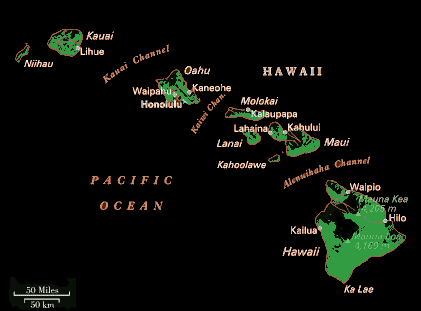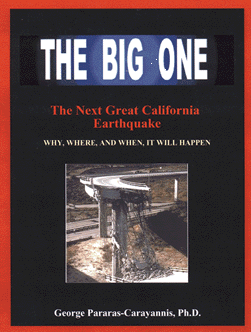|
The
April 1, 1946 Earthquake and Tsunami in the Aleutian Islands
George
Pararas-Carayannis
(Excerpts from the archives
to the Catalog of Tsunami in the Hawaiian Islands. World Data
Center A- Tsunami U.S. Dept. of Commerce Environmental Science
Service Administration Coast and Geodetic Survey, May 1969)
 
 One of the most destructive Pacific-wide tsunamis
- and the most severe in the Hawaiian islands - was generated
by a large earthquake near Unimak in the Aleutian chain of islands
of Alaska. One of the most destructive Pacific-wide tsunamis
- and the most severe in the Hawaiian islands - was generated
by a large earthquake near Unimak in the Aleutian chain of islands
of Alaska.
The earthquake occurred
on April 1, 1946, at 12:29 GMT. Its epicenter was at 52.8°
N, 163.5° W, and its focal depth was shallow at 25 km.
Although the quake
was initially assigned a Richter magnitude of 7.2, in later years,
the energy it released was reevaluated and a Moment Magnitude
(Mw) of 8.6 was assigned. to this event.
 This earthquake generated one of the most destructive This earthquake generated one of the most destructive
 Pacific-wide tsunamis of the 20th century. Near
the generating area, at Unimak Island, huge tsunami waves reached
35.0 m (more than 100 feet) above sea level and destroyed completely
the newly built, U.S. Coast Guard's Scotch Cap lighthouse. All
5 men of its crew were killed. The lighthouse was a steel-reinforced
concrete structure and its base was at about 30 meters above
sea level. Pacific-wide tsunamis of the 20th century. Near
the generating area, at Unimak Island, huge tsunami waves reached
35.0 m (more than 100 feet) above sea level and destroyed completely
the newly built, U.S. Coast Guard's Scotch Cap lighthouse. All
5 men of its crew were killed. The lighthouse was a steel-reinforced
concrete structure and its base was at about 30 meters above
sea level.
Scotch Cap
Lighthouse on Unimak Island, Alaska, before and after the April
1, 1946 earthquake and tsunami. (U.S. Coast Guard photographs)
Tsunami
waves advancing across Coconut Island, at the Hilo Bay waterfront.
(ITIC Archives; Photograph by Ted Lusdy).
 The
tsunami continued on to the Hawaiian Islands reaching The
tsunami continued on to the Hawaiian Islands reaching the
north shore of Kauai island first, approximately 4.5 hours after
the earthquake, and Hilo, 4.9 hours later. the
north shore of Kauai island first, approximately 4.5 hours after
the earthquake, and Hilo, 4.9 hours later.
A bore advances
past the railroad bridge at the mouth of the Wailuku River, Hilo
Bay, Hawaii. (ITIC archives; Honolulu Advertiser photograph).
There had been no
warning to Hawaii as the Tsunami Warning System had not been
established, at that time. The tsunami was extremely damaging
in all the islands, but it was particularly devastating in the
Island of Hawaii.
  The
town of Hilo on the island of Hawaii was pounded by a series
of 6 to 7 large tsunami waves coming in at 15-20 minute intervals.
The highest of these waves had a run up height of 8.1 meters
above sea level. The damage was extensive. The waves completely
destroyed Hilo's waterfront killing 159 people there. Every house
on the main street facing Hilo Bay was ripped off its foundation
and was carried across the street smashing against buildings
on the other side. The
town of Hilo on the island of Hawaii was pounded by a series
of 6 to 7 large tsunami waves coming in at 15-20 minute intervals.
The highest of these waves had a run up height of 8.1 meters
above sea level. The damage was extensive. The waves completely
destroyed Hilo's waterfront killing 159 people there. Every house
on the main street facing Hilo Bay was ripped off its foundation
and was carried across the street smashing against buildings
on the other side.
Tsunami
waves striking the beach front area at the Puumaile Tuberculosis
Hospital area, east of Hilo. Waves of up to 6.1 m high overtopped
the breakwater in this area and flooded the lower level of the
hospital (ITIC archives; Photograph source Mrs. Harry A. Simms,
Sr.)
 Another view of the
tsunami striking the beach front area in front of the Puumaile
Tuberculosis Hospital, in the eastern side of Hilo. (ITIC Archives;
Photograph source Mrs. Harry A. Simms, Sr.) Another view of the
tsunami striking the beach front area in front of the Puumaile
Tuberculosis Hospital, in the eastern side of Hilo. (ITIC Archives;
Photograph source Mrs. Harry A. Simms, Sr.)
At Pololu Valley,
on Hawaii, tsunami waves of over 12.0 m struck a school at Hawaii's
Laupahoehoe Point, and killed a number of childrenand also destroyed
a hospital. . Altogether a total 165 people lost their lives
from this tsunami. Damage to property was estimated to be over
$26 million (1946 dollars). 
A tsunami
wave advancing past an auto bridge at Wailuku River in Hilo Bay
(ITIC Archives; Honolulu Advertiser photograph).
  In
1948, and as As a result of this tsunami, the Pacific Tsunami
Warning Center was established in Hawaii. This warning system
was expanded in later years and became the headquarters of the
International Pacific Warning System. In
1948, and as As a result of this tsunami, the Pacific Tsunami
Warning Center was established in Hawaii. This warning system
was expanded in later years and became the headquarters of the
International Pacific Warning System.
Remnants
of a clubhouse, along Kamehameha Avenue, along Hilo's waterfront.,
Hawaii (ITIC Archives; Photograph by U.S. Army Corps of Engineers).
 Downtown
Hilo after the 1946 tsunami (Honolul Advertizer photo)
Downtown
Hilo after the 1946 tsunami (Honolul Advertizer photo)

References
Bodle, R.R. (1946). Note on the earthquake
and seismic sea wave of April 1, 1946, Transactions, Am. Geophys.
Union, 27, 464-465.
Cox D.C. and G. Pararas-Carayannis
(1976). Catalog of tsunamis in Alaska revised 1976, World Data
Center A, NOAA, Boulder, CO, Report SE-1, 43 pp.
Furumoto, A.S. (1991). Source parameters
of destructive tsunamis, Sci. Tsunami Haz., 9, 95-113.
Green, C.K. (1946). Seismic wea wave
of April 1, 1946, as recorded on tide gages, Transactions, Am.
Geophys. Union, 27, 490-500.
Iida, K., D.C. Cox, and G. Pararas-Carayannis
(1967). Preliminary catalog of tsunamis occurring in the Pacific
Ocean, Hawaii Inst. of Geophys., HIG-67-10, University of Hawaii,
131 pp.
Johnson, J.M. and K. Satake (1997).
Estimation of seismic moment and slip distribution of the April
1, 1946, Aleutian tsunami earthquake, J. Geophys. Res., 102,
11765-11774.
Kanamori, H. (1972). Mechanism of
tsunami earthquakes, Phys. Earth Planet. Interiors, 6, 346-359.
Lander, J.F. (1996). Tsunamis Affecting
Alaska 1737-1996, NGDC Key to Geophysical Record Documentation
No. 31, NOAA, NESDIS, NGDC, 195 pp.
Lander, J.F., P.A. Lockridge, and
M.J. Kozuch (1993). Tsunamis Affecting the West Coast of the
United States 1806-1992, NGDC Key to Geophysical Record Documentation
No. 29, NOAA, NESDIS, NGDC, 242 pp.
Lockridge, P.A. (1987). Devastating
tsunami inspires efforts to reduce future tsunami destruction,
Earthquakes and Volcanoes, 19, 60-64.
Mooney, M.J. (1976). Tidal Wave!,
Alaska Magazine, June, 1976, 25-27.
Pararas-Carayannis, G. (1969). Catalog of Tsunami in the Hawaiian
Islands. World Data Center A- Tsunami U.S. Dept. of Commerce
Environmental Science Service Administration Coast and Geodetic
Survey, May)
Sanford, H.B. (1946). Log of Coast
Guard Unit Number 368, Scotch Cap DF station relating to the
Scotch Cap light staion tragedy of 1946, U.S. Coast Guard, Washington,
D.C. 11 pp.
 RETURN TO
RETURN TO

Links
to other Pages
 NEW BOOK - THE
BIG ONE- The Next Great California Earthquake
NEW BOOK - THE
BIG ONE- The Next Great California Earthquake
 now available from
Amazon, Barnes and Noble and other major bookstores. It can be
also ordered by contacting directly Aston
Forbes Press.
now available from
Amazon, Barnes and Noble and other major bookstores. It can be
also ordered by contacting directly Aston
Forbes Press.

OTHER MISCELLANEOUS NON-TECHNICAL WRITINGS



(©) Copyright
1963-2007 George Pararas-Carayannis / all rights reserved / Information
on this site is for viewing and personal information only - protected
by copyright. Any unauthorized use or reproduction of material
from this site without written permission is prohibited.
|